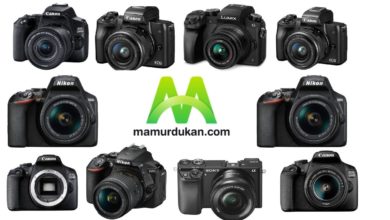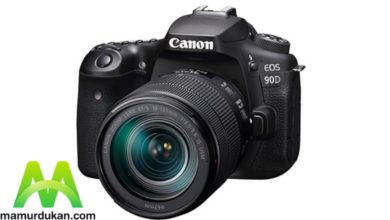| Price | 41500 BDT |
Canon EOS 2000D Specs:
Image Sensor
| Type | Approx. 22.3 mm x 14.9 mm CMOS |
| Pixels | Effective Pixels Approx. 24.1 megapixels Total Pixels Approx. 24.7 megapixels |
| Aspect Ratio | 3:2 |
Other Features
| Features | DIGIC 4+ |
Focusing
| Af Point | Via optical viewfinder: 9 AF points (f/5.6 cross-type at center) |
| Modes | Via optical viewfinder: AI Focus (Switches between One-Shot AF and AI SERVO AF automatically) One-Shot AF AI Servo Manual Via Live View LCD screen: One-Shot AF (Contrast-detect AF) Quick Mode (via phase-detection AF sensor) Manual |
Exposure Control
| Metering Modes | Via optical viewfinder: Evaluative via 63 zones dual-layer metering sensor (linked to all AF points) Partial (center, approx. 10% of viewfinder) Center-weighted average available Via Live View on LCD screen: Evaluative metering (315 zones) |
| ISO Sensitivity | AUTO(100-6400), 100-6400 in 1-stop increments ISO can be expanded to H: 128001 During Movie shooting: Auto (100-6400), 100-6400 (Whole stop increments) |
Shutter
| Shutter Speed | 30-1/4000 sec (1/2 or 1/3 stop increments), Bulb (Total shutter speed range. Available range varies by shooting mode) |
Shooting
| Color Space | sRGB and Adobe RGB |
| Continuous Shooting | Max. Approx. 3 fps for approx. 150 JPEG images, 11 images RAW5 6 |
File Type
| Image Type | JPEG: Fine, Normal (Exif 2.30 compliant) / Design rule for Camera File system (2.0), RAW: RAW (14bit, Canon original RAW 2nd edition), Digital Print Order Format [DPOF] Version 1.1 compliant |
| Image Size | JPEG 3:2: (L) 6000 x 4000, (M) 3984 x 2656, (S1) 2976 x 1984, (S2) 1920 x 1280, (S3) 720 x 480 JPEG 4:3: (L) 5328 x 4000, (M) 3552 x 2664, (S1) 2656 x 1992, (S2) 1696 x 1280, (S3) 640 x 480 JPEG 16:9: (L) 6000 x 3368, (M) 3984 x 2240, (S1) 2976 x 1680 (S2) 1920 x 1080, (S3) 720 x 408 JPEG 1:1: (L) 4000 x 4000, (M) 2656 x 2656, (S1) 1984 x 1984, (S2) 1280 x 1280, (S3) 480 x 480 RAW: (RAW) 6000 x 4000 |
| Movie Type | MOV (Video: H.264 interframe (IPB), Sound: Linear PCM, recording level can be manually adjusted by the user) |
| Movie Size | 1920 x 1080 (30, 25, 24 fps) 1280 x 720 (60, 50 fps) 640 x 480 (30, 25 fps) |
LCD Monitor
| Size | 7.5 cm (3.0″) TFT LCD, approx. 920 K dots |
| Viewing Angle | Approx. 170° |
Storage
| Storage Type | SD card, SDHC card, or SDXC card |
Flash
| Built-in Flash | 9.2 |
| Red-Eye Reduction | Yes – with red-eye reduction lamp |
| External Flash Compatibility | E-TTL II with EX-series Speedlites |
Power Source
| Batteries | 1 x Rechargeable Li-ion Battery LP-E10 |
Physical Specification
| Dimensions (W x H x D) | 129.0 x 101.3 x 77.6mm |
| Weight (Body Only) | Approx. 475 g (CIPA testing standard, including battery and memory card) |
Lens
| Lens Mount | EF/EF-S |
| Focus Length | Equivalent to 1.6x the focal length of the lens |
| Maximum Aperture | Aperture priority AE |
Manufacturer Warranty
| Warranty | 03 Years Service Warranty (No parts warranty) |
Canon EOS 2000D price in Bangladesh
The EOS 2000D goes a long way ahead. It comes at a price of 41500 BDT.
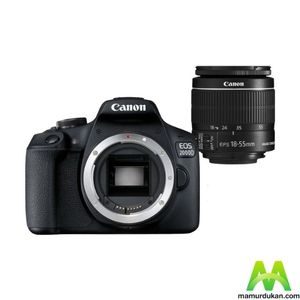
Body
The Canon EOS 2000D has a plastic body that feels like sturdy. The mount is made of interior, so you can change lenses much with confidence if you wish. The body has a single control dial, a rotary nubble for tagging the asked program and a separate on/ off switch so that you can always leave the camera in your favorite model. On the tail are the buttons that you find on fair every consumer camera from Canon, with symbols in white and blue. The white symbols indicate the function while pop; the blue bones, during the review of the images. On top of the camera is the raised-in flash, which can be folded up at the touch of a button on the top cover.
Screen & Viewfinder of Canon EOS 2000D
The 2000D viewfinder isn’t as big and clear as the more big-ticket models, but it does have a diopter setting. This allows eyeglass wearers to get the image impeccably sharp. It shows about 95 of the frame. So you always get a bit more in the photo than you see in the viewfinder. The screen is 3 ″, or7.6 cm, and has pixels. That’s damages for working with. It does only not touch–sensitive, and you can not turn it or angle it. That’s not a problem for photography, but for video or selfies, it’s inferior useful.
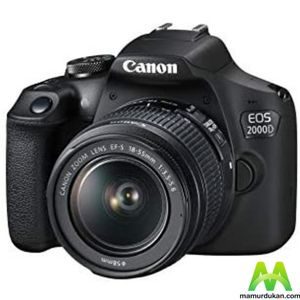
Menu & Operation of Canon EOS 2000D
Canon’s menus are logical and clear. As a starting lensman, you’ll fast come familiar with the capabilities of the 2000D. The control buttons on the rear of the camera also speak for themselves. As a real entry camera, the 2000D is equipped with a single command dial, so that man-made operation requires that you press an excess button to switch between hole and shutter speed. Most likely, the camera will be used more hourly in one of the (semi-) automatic modes, and that’s why this isn’t a real problem for the target group. Really nice is that the screen gives you lots of tips. However, for exemplar, the screen will display two images in the Box (Time Value or Time Priority) mode that shows the effect of a short and long shutter speed, If you use the Guided Menu System. You can either freely choose which effect you want and which way you should turn the chunk. For babes, this is a really intuitive way to learn how to mug.
Image Quality of Canon EOS 2000D
Thanks to the 24-megapixel sensor, you can use the 2000D to work images that are sharp and well– detailed. It’s in fact the same or that you find in cameras suchlike as the EOS 80D and 7D Mark II. And those are used without problems for professional work. The 2000D is the cheapest camera with which you can achieve the same quality, and, with that, it may yea be a budget–friendly permanent camera for advanced shutterbugs.
Dynamic Range of Canon EOS 2000D
Canon has taken significant path in the field of dynamic range in recent years. You can see those expenditures in the 24-megapixel sensor of the 2000D. There are competitions who are doing a little better, but in practice, the 2000D is generally fine. The dynamic range is definitely better than that of cameras with the ancient 18-megapixel sensor like the 1300D and 4000D. That means that you can clear up dark better without being bothered by fancy noise or banding. And the image quality is also good if you apply a substantial exposure correction to an accidentally underexposed image.
Color Reproduction
The color reproduction has been one of Canon’s strengths for years and the reason why many photographers remained loyal to the brand. Sassy colors and strong contrasts, but at the same time few annoying overtones in skin tones or shadows ensure beautiful reproduction.
Noice of Canon EOS 2000D
The 24-megapixel sensor of the 2000D is a whole generation newer than the 18-megapixel sensor of its precursor, the 1300D. And that’s reflected in the noise. At high ISO values, this is smaller than on the 1300D. And that remains good when you consider that the 2000D has 6 megapixels more on the same skin. ISO 3200 is really usable and ISO 6400 is as well, but soon shoot in RAW and edit the images yourself. The standard noise reduction in the 2000D works effectively, but also causes further loss of detail than necessary or possibly desirable. ISO does n’t look that good, and you should only use it in extreme need, or if you’re sure that you’ll only show the screen small.
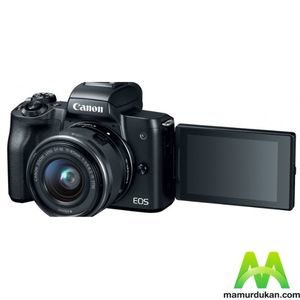
Video Quality of Canon EOS 2000D
The Canon EOS 2000D can, like the 1300D, film in full HD (1920 × 1080 pixels) in 30 or 24 frames per second. Slow– stirring is also possible in HD format (1280 × 720 pixels) up to 60 images per second. The bitrate is 46 Mbps, and that’s reasonable. Canon usesH. 264 as squeezing, and that makes handy trains that are easy to playback. 4K isn’t an option. For recording, you have to reckon on the screen on the tail of the camera, and you can not turn that or fold it out. The 2000D is so not suitable for selfies. That screen also has a 34 rate. As a result, you do n’t use all of it when you take a picture of substance, but with videotape, you have yea more problems with it. The camera also has no microphone or headphone input, just like other entry models from Canon. Of course, you would fair want to say, given the price. It does mean that you’re dependent on the reared-in microphone that only records in mono for the recording of sound. For stereo, you’ll so have to use an external documenter and concur the sound thereafter. But either the tenderfoot’s stage is long gone.
Image Stabilization
The Canon EOS 2000D has, like all other SLRs from Canon, no pieced-in image stabilization. But you can of course combine the camera with lenses that do. And if you’re interested in the 2000D, choose the 18-55 mm with IS or, yea better the 18-135 mm with image stabilization. Either you can still shoot nicely well by hand when the light is n’t that great.
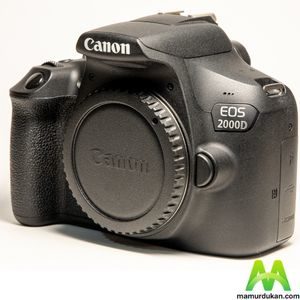
Canon EOS 2000D Autofocus
The AF system of the 2000D is the old 9- point system that has been around for about a decade. It works and is also fleetly, but of course, it doesn’t offer the far-reaching content or advanced pursuit options that newfangled systems offer in ( material) more precious cameras. Of course, the 2000D, with its three images per second, isn’t a camera that you’ll want to use for fast-action sports. For normal use, you can work well with that 9- point AF. What you might miss if you want to use the screen a lot is the Dual Pixel AF, which provides quick and accurate focus in live view in more precious models. However, you have to work with the slow distance- spotting AF, If you use the screen. That’s accurate, but not fleetly.
Pros & Cons of Canon EOS 2000D
Pros
- Competitively priced
- Good image quality
- 24-megapixel sensor
- Lightweight
- Familiar operation
- Helpful help function in the menus
- Metal mount
Cons
- Simple AF system
- Small viewfinder
- No touchscreen
- No good AF in live view
If you are interested to watch some latest laptops which are available on the market, please check this out. Latest laptops in Bangladesh Also if you want to see the latest smartphones, please check these out!!! Smartphones Our information may not be 100% accurate. To clarify, you can visit their official site Canon
41,500 Taka
Pros
- Competitively priced
- Good image quality
- 24-megapixel sensor
- Lightweight
- Familiar operation
- Helpful help function in the menus
- Metal mount
Cons
- Simple AF system
- Small viewfinder
- No touchscreen
- No good AF in live view
The AF system of the 2000D is the old 9- point system that has been around for about a decade. It works and is also fleetly, but of course, it doesn’t offer the far-reaching content or advanced pursuit options that newfangled systems offer in ( material) more precious cameras. Of course, the 2000D, with its three images per second, isn’t a camera that you’ll want to use for fast-action sports. For normal use, you can work well with that 9- point AF. What you might miss if you want to use the screen a lot is the Dual Pixel AF, which provides quick and accurate focus in live view in more precious models. However, you have to work with the slow distance- spotting AF, If you use the screen. That’s accurate, but not fleetly.
The Canon EOS 2000D has, like all other SLRs from Canon, no pieced-in image stabilization. But you can of course combine the camera with lenses that do. And if you’re interested in the 2000D, choose the 18-55 mm with IS or, yea better the 18-135 mm with image stabilization. Either you can still shoot nicely well by hand when the light isn’t that great.
Thanks to the 24-megapixel sensor, you can use the 2000D to work images that are sharp and well-detailed. It’s in fact the same or that you find in cameras suchlike as the EOS 80D and 7D Mark II. And those are used without problems for professional work. The 2000D is the cheapest camera with which you can achieve the same quality, and, with that, it may yea be a budget-friendly permanent camera for advanced shutterbugs.

